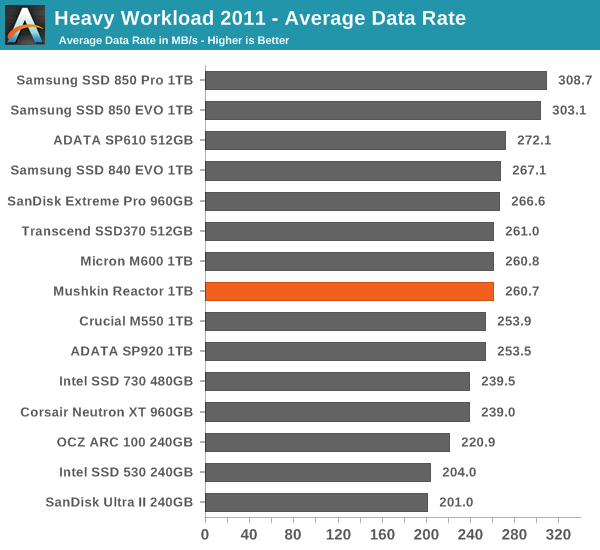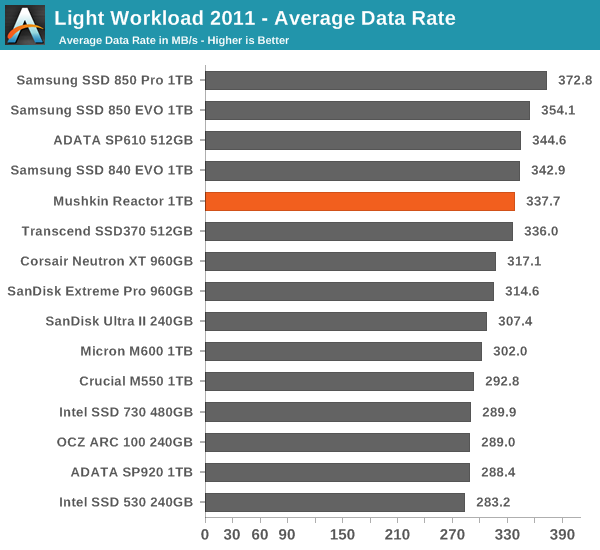Mushkin Reactor 1TB SSD Review
by Kristian Vättö on February 9, 2015 11:32 AM EST- Posted in
- Storage
- SSDs
- Mushkin
- Silicon Motion
- SM2246EN
- Reactor
- Micron 16nm
AnandTech Storage Bench 2011
Back in 2011 (which seems like so long ago now!), we introduced our AnandTech Storage Bench, a suite of benchmarks that took traces of real OS/application usage and played them back in a repeatable manner. The MOASB, officially called AnandTech Storage Bench 2011 – Heavy Workload, mainly focuses on peak IO performance and basic garbage collection routines. There is a lot of downloading and application installing that happens during the course of this test. Our thinking was that it's during application installs, file copies, downloading and multitasking with all of this that you can really notice performance differences between drives. The full description of the Heavy test can be found here, while the Light workload details are here.

The strong performance continues in our 2011 Storage Benches. Only Samsung has found the secret recipe to providing noticeable performance gains, whereas the majority of other drives are very close and that applies to the Reactor as well.











69 Comments
View All Comments
Shadowmaster625 - Friday, February 13, 2015 - link
That's because SSDs are old and antiquated. NAND should be right on the DIMMs with DRAM, sharing the same bus, the same memory controller, as much of the same hardware as possbile. It should have started 3 years ago and by now we should have had 4GB DRAM + 64GB NAND DIMMs for $120 a pair and 8GB + 128GB for $200 a pair.akrobet - Monday, February 9, 2015 - link
What is holding back the adoption of NVMe M.2 drives?AnnihilatorX - Monday, February 9, 2015 - link
I think: Lack of Chipset support, require most recent OSes, lack of boot support, competing standards -> general consumer confusion (SATA Express vs M.2), Rarity of motherboards with M.2, cost.There is not one specific reason holding back, but I guess you can just say with all new tech adoption will be low at first, and this would be the explanation.
galta - Monday, February 9, 2015 - link
I boot with my Plextor M.2dgingeri - Monday, February 9, 2015 - link
The M6e doesn't do NVMe. It's AHCI, which restricts performance somewhat.BillyONeal - Monday, February 9, 2015 - link
The article says that you don't think the 850 EVO is worth 60 dollars more; but in the list they're the same price. Typo?Kristian Vättö - Monday, February 9, 2015 - link
Read the full sentence."That said, if the prices go up to $450 again, the Reactor will become a better choice because despite the performance and features I don't find the 850 EVO to be worth $60 more."
Kristian Vättö - Monday, February 9, 2015 - link
I also edited it to be more clear now.BillyONeal - Monday, February 9, 2015 - link
Makes sense. Thanks!Andy Chow - Monday, February 9, 2015 - link
A 1TB drive with 144 TB endurance? No thanks!